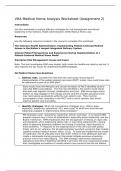VHA Medical Home Analysis Worksheet (Assignment 2)
Instructions:
Use this worksheet to analyze effective strategies for risk management and ethical
leadership in the Veterans Health Administration (VHA) Medical Home case.
Resources:
Use the following resources located in the course to complete this worksheet:
The Veterans Health Administration: Implementing Patient-Centered Medical
Homes in the Nation’s Largest Integrated Delivery System
Veteran Patient Perspectives and Experiences During Implementation of a
Patient-Centered Medical Home Model
Enterprise Risk Management: Issues and Cases
Note: This text investigates ERM case studies, both inside the healthcare industry and out. It
also explores the key issues for implementing ERM strategies.
HA Medical Home Case Questions
1. Address risks. Consider the risks from the case study concerning the
implementation of the patient-aligned care team (PACT) model. How could these risks
be addressed as part of an ERM plan?
Early results from the Memphis and Lincoln formation of PACT identified several
risks that ERM could address. The first risk identified is the need to build teams
that work well together through collaboration and trust. ERM encourages senior
leaders to stay engaged in the change process and this includes physicians that
may resist giving up absolute authority over patient care. They must be
encouraged to trust coworkers in the PACT and to solicit opinions that would
improve patient care and safety.
2. Identify strategies. What risk management strategies (e.g., ethical, legal,
regulatory, leadership, operational, etc.) were used? At what level and how was
leadership engaged in implementing those strategies?
RM strategies used: operational, leadership, ethical, and legal. A successful ERM
program requires buy-in from all stakeholders, especially senior leadership, and the
Board of Directors. ERM emphasizes that the old approach of relying on rigid rules
and standards, when addressing safety risks, is now being replaced with a group
effort of detecting potential problems and having a proactive, rapid response to
those problems. In response to the ongoing failure of the VA to provide quality,
timely care to our veterans, the VA administration launched a program that created
‘patient-centered medical homes’ (Klein, 2011). To build and implement this model
of healthcare, the VA allocated more than $227 million to hire additional staff and
create a nationwide training program that would mitigate previous scheduling
practice errors from redeveloping. This ERM strategic intervention addressed
operational and ethical liabilities identified in previous OIG and congressional audits
that investigated accusations of unsafe patient care practices that did not adhere
, to VA policy and procedures.
3. Evaluate risks for implementation. What risks were involved in implementing
those strategies?
All risk must be identified when creating a strategic plan. To accurately develop
the strategic plan, leadership and the risk manager must consider what changes
have already taken place in the organization and/or what changes are predicted for
the organization. The pursuit of identifying risks must be shared with all
stakeholders in the delivery-of-care area (leadership, providers, nurses, medical
assistants, and support staff). Strengths and weaknesses must be evaluated, while
keeping in mind the ultimate goal of patient safety. It has been well documented
that the VA, over a long period of time, failed to successfully implement the
recommendations for improved scheduling practices and capture of accurate data
metrics. An identified risk is the strength/weakness of the current leadership and
their commitment to the ERM process. An internal risk assessment may reveal risk
associated with creating integrated health teams. In the creation of PACT, the VA
was required to redesign its care delivery to incorporate less traditional methods of
in-person office visits to video, telephone, or email appointments with patients.
Transitioning to this model of care delivery depends on extensive trust-building
exercises for physicians that are used to being the only provider guiding a patient’s
care. When evaluating external risks, financial and regulatory categories are
identified. Healthcare insurance companies and federal healthcare plans are now
transitioning from fee-for-service models to reimbursement rates being determined
by patient satisfaction results and legislative determinations of quality-of-care that
was received. A financial risk assessment must be done to evaluate the
organization’s ability to estimate the economic value in instituting the PACT model.
4. Assess leadership measures in the VHA Medical Home case. In contrast to the
PVAHCS case, what leadership oversight and accountability measures are present in
the team-based models in the VHA Medical Home case? How appropriate would the
identical measures be for monitoring performance in the PVAHCS case?
The VA administration leadership launched the PACT program in 2009 as part of the
VHA Transformational Initiatives (VHA Handbook, 2014) after years of scrutiny and
audits by the VA OIG. Documented widespread inappropriate scheduling practices,
delays in timely care and poor oversight and unethical management practices were
noted. In the PACT model, service-level managers must establish and implement
contingency plans for ensuring veterans continue to receive timely and appropriate
access to care even when there are issues with inadequate staffing, inadequate
resources, and natural disaster events (VHA PACT Handbook, 2014). Improved
communication is a goal of PACT. VA administration and managers are responsible
for ensuring team members receive required training in patient-centered
communication skills and PACT training that focuses on patient-centered, data
driven, continuously improving, team based, accessible, timely, comprehensive,
coordinated care (VHA PACT Handbook, 2014). The above changes were in
response to the OIG investigation of the VHA beginning in 2005. Instituting the
PACT model would have been appropriate during this timeframe. Leadership would
have been required to take a hands-on approach in addressing barriers in
communication, scheduling processes and patient satisfaction issues instead of
focusing on their own financial interests and encouraging lower level employees to
manipulate data which resulted in patient safety issues and wrongful deaths.




